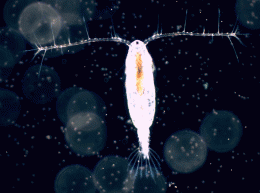The strongest animal in the world

The world's strongest animal, the copepod, is barely 1 mm long. It shows that copepods - in relation to their size - are more than 10 times as strong as has been previously documented for any other animal.
The world’s strongest animal, the copepod, is barely 1 mm long. It is also the world’s fastest animal and the most abundant multicellular animal on the planet. So what is it that makes the copepod so successful?
“The copepods’ evolutionary success should be seen in relation to their ability to flee from predators. Their escape jump is hugely powerful and effective,” says Professor Thomas Kiørboe from the National Institute of Aquatic Resources at the Technical University of Denmark (DTU Aqua).
Together with researchers from DTU Aqua and DTU Physics and with the aid of high-speed video recordings, Thomas Kiørboe has been able to give a detailed picture of the copepods’ escape jump. The powerful jump has made an incredible impression upon the researchers.
“They jump at a rate of half a metre per second, and that’s within a few thousandths of a second,” says Thomas Kiørboe, continuing: “It shows that copepods - in relation to their size - are more than 10 times as strong as has been previously documented for any other animal or even man-made motors...”
The results of the impressive escape jump have just been published in full in the Journal of the Royal Society Interface.
Fine-tuned swimming legs with superior gearing
The researchers have now concluded that the strength of the copepod is 10-30 times that measured in any other species, where the maximum force production is surprisingly constant.
“The explanation is that the copepod has two separate propulsion mechanisms,” says Thomas Kiørboe, DTU Aqua.
While other species have just one mechanism for movement (e.g. a bird’s wings, or a horse’s legs), and due to the risk of ‘material fatigue’, there is a maximum limit on the force production in a propulsion mechanism that is used almost constantly.
The copepod has vibrating feeding limbs that create a feeding current, while at the same time allowing it to move or swim almost continously. In addition, it has 4-5 pairs of swimming legs or jumping legs, which allows it to jump in order to escape or to attack. These are used less frequently and very briefly. The muscles in the two systems are fairly similar, but the gearing of the jumping mechanism is tuned to short bursts of immense force.
“The copepod does not experience material fatigue, because it has two systems of movement at its disposal. The swimming legs, which it uses to jump, are finely tuned, and the copepod’s hydro-dynamic design is optimised for high speeds, making the escape jump unusually forceful and fast,” explains Thomas Kiørboe.
Highly developed senses
Even though the copepod is both blind and so tiny that the water feels as thick as syrup, it has managed to solve the engineering feat of fleeing quickly and efficiently from predators. The solution is the two propulsion mechanisms with different gearing. Its well-developed senses interpret extremely quickly signals from the ambient and sends the message on to the swimming legs. This is made possible by a nerve transmission system that is exceptionally rapid for an invertebrate animal, and which can be explained by the special design of the neural pathways. The streamlined, hydro-dynamic shape and pure muscular strength of the copepod is what explains its most powerful jump.
More information: Read more in the Journal of the Royal Society Interface: rsif.royalsocietypublishing.or … f.2010.0176.abstract
Provided by Technical University of Denmark



















